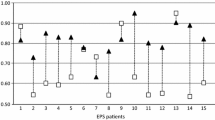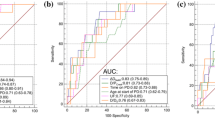Abstract
Background
The present study was conducted to clarify the clinical risk factors related to the development of encapsulating peritoneal sclerosis (EPS), which is one of the most serious complications in patients undergoing peritoneal dialysis (PD).
Methods
The records of 78 patients with a history of PD treatment, including 18 with EPS, were retrospectively analyzed (male/female, 51:27; age, 51.8 ± 11.0 years; PD treatment, 94.1 ± 42.7 months). The inclusion criteria were: duration of PD more than 24 months; 36-month follow up after discontinuation of PD; available data for dialysate-to-plasma creatinine ratio (D/P Cr), by fast peritoneal equilibration test within 3 months before PD discontinuation; and absence of EPS at PD discontinuation. Analytical parameters included age, sex, underlying renal disease, duration of PD, membrane transport state (higher transporter or lower transporter: D/P cr ratio more than or less than 0.75), number of episodes of peritonitis during PD treatment, performance of peritoneal lavage after PD discontinuation, and reasons for PD withdrawal (ultrafiltration failure, acute peritonitis, social matters).
Results
Significant differences were noted regarding the PD duration, D/P cr, higher membrane transport state, and number of peritonitis episodes during PD. On receiver operating characteristic curves, the cutoff points for EPS were: D/P cr ratio, 0.74; number of peritonitis episodes, 2; and PD duration (months), 115.2. Multivariate analysis, employing the factors age, PD duration, higher membrane transport state, and number of peritonitis episodes, which were selected by stepwise analysis, identified the latter two factors as significant for the development of EPS (odds ratio [OR], 4.0; P = 0.046 and OR, 12.0; P = 0.049, respectively).
Conclusions
A higher transporter membrane state and the number of peritonitis episodes are factors contributing to the occurrence of EPS in patients who have experienced PD treatment.
Similar content being viewed by others
References
VC Gandhi HM Humayun TS Ing JT Daugirdas VR Jablokow S Iwatsuki et al. (1980) ArticleTitleSclerotic thickening of the peritoneal membrane in maintenance peritoneal dialysis patients Arch Intern Med 140 1201–3 Occurrence Handle10.1001/archinte.140.9.1201 Occurrence Handle1:STN:280:Bi%2BB28vkt1A%3D Occurrence Handle7406618
Y Nomoto Y Kawaguchi H Kubo H Hirano S Sakai K Kurokawa (1998) ArticleTitleSclerosing encapsulating peritonitis in patients undergoing continuous ambulatory peritoneal dialysis: a case report of the Japanese Sclerosing Encapsulating Peritoneal Study Group Am J Kidney Dis 28 420–7
H Kawanishi Y Kawaguchi (2000) ArticleTitlePrevalence and therapeutic outcome of sclerosing encapsulating peritonitis (SEP). A multicenter study in Japan (in Japanese) Jin To Touseki (Kidney Dial) 49 IssueIDs1 225–8
H Kawanishi Y Kawaguchi H Fukui S Hara A Imada H Kubo et al. (2004) ArticleTitleEncapsulating peritoneal sclerosis in Japan: a prospective, controlled, multicenter study Am J Kidney Dis 44 729–37 Occurrence Handle15384025
IE Afthentopoulous P Passadakis DG Oreopoulos (1998) ArticleTitleSclerosing peritonitis in continuous ambulatory peritoneal dialysis patient: one centers experience and review of the literature Adv Ren Replace Ther 5 157–67 Occurrence Handle9686626
M Flanigan D Anderson RM Freeman (1984) ArticleTitlePeritoneal dialysis complicated by fungal peritonitis and peritoneal fibrosis Am J Med 76 A113–25 Occurrence Handle10.1016/0002-9343(84)91017-9 Occurrence Handle1:STN:280:BiuB3c%2FhvFU%3D Occurrence Handle6720720
CG Chew AR Clarkson RJ Faull (1997) ArticleTitleRelapsing CAPD peritoneal sclerosis due to Haemophilus influenzae Nephrol Dial Transplant 12 821–2 Occurrence Handle10.1093/ndt/12.4.821 Occurrence Handle1:STN:280:ByiB1crotVM%3D Occurrence Handle9141024
Brown P, Baddeley H, Read AE, Davies JD, McGarry J. Sclerosing peritonitis, an unusual reaction to a beta-adrenergic-blocking drug (practolol). Lancet 1974;II:1477–81
Oreopoulos DG, Khanna R, Wu G. Sclerosing obstructive peritonitis after CAPD (letter). Lancet 1983;II:409
A Slingeneyer C Mion G Mourad B Canaud B Faller JJ Breraud (1983) ArticleTitleProgressive sclerosing peritonitis: a late severe complication of maintenance peritoneal dialysis Trans Am Soc Artif Intern Organs 29 633–40 Occurrence Handle1:STN:280:BiuC2sznvFA%3D Occurrence Handle6673302
BRJ Junor JD Briggs MA Forwell JW Dobbie I Henderson (1985) ArticleTitleSclerosing peritonitis: the contribution of chorhexidine in alcohol Perit Dial Bull 5 101–4
M Nakayama (2001) ArticleTitleThe greater incidence of encapsulating peritoneal sclerosis is not the result of overdiagnosis Perit Dial Int 21 IssueIDs3 S72–4 Occurrence Handle11887867
RJ Rigby CM Hawley (1998) ArticleTitleSclerosing peritonitis: the experience in Australia Nephrol Dial Transplant 13 154–9 Occurrence Handle10.1093/ndt/13.1.154 Occurrence Handle1:STN:280:DyaK1c7kt1Ogsw%3D%3D Occurrence Handle9481732
M Nakayama M Ikeda N Katoh H Hayakawa M Numata Y Otsuka et al. (2002) ArticleTitleLong-standing high-transport membrane as a risk factor for EPS development after PD withdrawal: an analysis based on changes in peritoneal function during and after CAPD withdrawal (in Japanese Nippon Jinzo Gakkai Shi (Jpn J Nephrol) 44 396–401
R Yamamoto M Nakayama T Hasegawa N Miwako H Yamamoto K Yokoyami et al. (2002) ArticleTitleHigh-transport membrane is a risk factor for encapsulating peritoneal sclerosis developing after long-term continuous ambulatory peritoneal dialysis treatment Adv Perit Dial 18 131–4 Occurrence Handle1:CAS:528:DC%2BD3sXntFarsb8%3D Occurrence Handle12402604
M Nakayama H Yamamoto M Ikeda T Hasegawa N Kato H Takahashi et al. (2002) ArticleTitleRisk factors and preventive measures for encapsulating peritoneal sclerosis – Jikei experience 2002 Adva Perit Dial 18 144–8
Y Kawaguchi H Kawanishi S Mujais N Topley DG Oreopoulos (2000) ArticleTitleEncapsulating peritoneal sclerosis: definition, etiology, diagnosis, and treatment. International Society for Peritoneal Dialysis Ad Hoc Committee on Ultrafiltration Management in Peritoneal Dialysis Perit Dial Int 20 IssueIDs4 S43–55 Occurrence Handle11098928
Nakayama M, Yamamoto H, Terawaki H, Oi K, Kamijyo T, Yokoyama K, et al. Longitudinal changes of peritoneal permeability after withdrawal from long-term CAPD treatment. A preliminary study to explore the peritoneal pathophysiology after CAPD treatment (in Japanese). J Jpn Soc Dial Ther 33:1137–42, 200
M Numata M Nakayama S Nimura M Kawakami B Lindholm Y Kawaguchi (2003) ArticleTitleAssociation between an increased surface area of peritoneal microvessels and a high peritoneal solute transport rate Perit Dial Int 23 116–22 Occurrence Handle12713076
M Goldman P Vandenabeele J Moulart Z Amraoui D Abramowicz J Nortier et al. (1990) ArticleTitleIntraperitoneal secretion of interleukin-6 during continuous ambulatory peritoneal dialysis Nephron 56 277–80 Occurrence Handle1:STN:280:By6C2s3jsFY%3D Occurrence Handle2077410
D Zemel RT Krediet (1996) ArticleTitleCytokine patterns in the effluent of continuous ambulatory peritoneal dialysis: relationship to peritoneal permeability Blood Purif 14 198–216 Occurrence Handle1:STN:280:BymB2M3mslE%3D Occurrence Handle8785036
M Nakayama Y Kawaguchi K Yamada T Hasegawa K Takazoe N Katoh et al. (1997) ArticleTitleImmunohistochemical detection of advanced glycosylation end-products in the peritoneum and its possible pathophysiological role in CAPD Kidney Int 51 182–6 Occurrence Handle1:STN:280:ByiC2cfptVM%3D Occurrence Handle8995732
M Nakayama A Sakai M Numata T Hosoya (2003) ArticleTitleHyper-vascular change and formation of advanced glycation endproducts in the peritoneum caused by methylglyoxal and the effect of an anti-oxidant, sodium sulfite Am J Nephrol 23 390–4 Occurrence Handle10.1159/000074065 Occurrence Handle1:CAS:528:DC%2BD3sXptVWkt74%3D Occurrence Handle14551463
R Inagi T Miyata T Yamamoto D Suzuki K Urakami A Saito et al. (1999) ArticleTitleGlucose degradation product methylglyoxal enhances the production of vascular endothelial growth factor in peritoneal cells: role in the functional and morphological alterations of peritoneal membranes in peritoneal dialysis FEBS Lett 463 260–4 Occurrence Handle10.1016/S0014-5793(99)01642-7 Occurrence Handle1:CAS:528:DyaK1MXnvFemtrw%3D Occurrence Handle10606733
B Musi M Braide A Wieslander A Rippe A Albrektsson T Henle et al. (2001) ArticleTitleVery high daily intraperitoneal doses of carbonyl compounds affect the morphology, but not the exchange characteristics, of rat peritoneum Blood Purif 19 286–92 Occurrence Handle10.1159/000046956 Occurrence Handle1:CAS:528:DC%2BD3MXislCrtLo%3D Occurrence Handle11244188
G Garosi N Di Paolo (2000) ArticleTitlePeritoneal sclerosis: one or two nosological entities Semin Dial 13 297–308 Occurrence Handle10.1046/j.1525-139x.2000.00080.x Occurrence Handle1:STN:280:DC%2BD3cvmt1Knsg%3D%3D Occurrence Handle11014691
M Numata M Nakayama T Hosoya CM Hoff CJ Holmes M Schalling et al. (2004) ArticleTitlePossible pathological involvement of receptor for advanced glycation endproducts (RAGE) for development of encapsulating peritoneal sclerosis in Japanese CAPD patients Clin Nephrol 62 455–60 Occurrence Handle1:CAS:528:DC%2BD2MXhs1Glsw%3D%3D Occurrence Handle15630905
Author information
Authors and Affiliations
Corresponding author
About this article
Cite this article
Yamamoto, R., Otsuka, Y., Nakayama, M. et al. Risk factors for encapsulating peritoneal sclerosis in patients who have experienced peritoneal dialysis treatment. Clin Exp Nephrol 9, 148–152 (2005). https://doi.org/10.1007/s10157-005-0349-8
Received:
Accepted:
Issue Date:
DOI: https://doi.org/10.1007/s10157-005-0349-8




